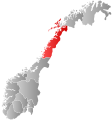Dverberg (municipality)
Dverberg herred | |
|---|---|
 Nordland within Norway | |
 Dverberg within Nordland | |
| Coordinates: 69°06′23″N 15°57′50″E / 69.1064°N 15.9640°ECoordinates: 69°06′23″N 15°57′50″E / 69.1064°N 15.9640°E | |
| Country | Norway |
| County | Nordland |
| District | Vesterålen |
| Established | 1 Jan 1838 |
| Disestablished | 1 Jan 1964 |
| Administrative centre | Dverberg |
| Area | |
| • Total | 279 km2 (108 sq mi) |
| *Area at municipal dissolution. | |
| Population (1964) | |
| • Total | 1,719 |
| • Density | 6.2/km2 (16/sq mi) |
| Time zone | UTC+01:00 (CET) |
| • Summer (DST) | UTC+02:00 (CEST) |
| ISO 3166 code | NO-1872 |
| Created as | Formannskapsdistrikt in 1838 |
| Succeeded by | Andøy in 1964 |
Dverberg is a former municipality in Nordland county, Norway. The municipality existed from 1838 until its dissolution in 1964. The municipality encompassed areas on the island of Andøya in what is now Andøy Municipality. Starting out at about 616 square kilometres (238 sq mi) in 1838, it was reduced in size in 1924. Upon its dissolution in 1964, the municipality was only 279 square kilometres (108 sq mi). The administrative centre was the village of Dverberg where Dverberg Church is located.[1][2]
History[]

The prestegjeld of Dverberg was established as a municipality on 1 January 1838 (see formannskapsdistrikt). It originally covered the whole island of Andøya as well as about 100 square kilometres (39 sq mi) on the northeastern tip of the large island of Hinnøya, plus a number of very small surrounding islets.[2]
On 1 January 1924, Dverberg municipality was divided into three. The northern part of Dverberg became the new municipality of Andenes (population: 2,213) and the southern part of Dverberg was separated to become the new municipality of Bjørnskinn (population: 1,410). This left 1,477 residents in Dverberg which now only covered the central part of the island of Andøya.
During the 1960s, there were many municipal mergers across Norway due to the work of the Schei Committee. On 1 January 1964, the neighboring municipalities of Bjørnskinn (population: 1,835), Andenes (population: 3,812), and Dverberg (population: 1,719) were all merged back together again to create the new Andøy Municipality.[1][3]
Government[]
All municipalities in Norway, including Dverberg, are responsible for primary education (through 10th grade), outpatient health services, senior citizen services, unemployment and other social services, zoning, economic development, and municipal roads. The municipality is governed by a municipal council of elected representatives, which in turn elects a mayor.[4]
Municipal council[]
The municipal council (Herredsstyre) of Dverberg was made up of 15 representatives that were elected to four year terms. The party breakdown of the final municipal council was as follows:
| Party Name (in Norwegian) | Number of representatives | |
|---|---|---|
| Labour Party (Arbeiderpartiet) | 7 | |
| Joint List(s) of Non-Socialist Parties (Borgerlige Felleslister) | 8 | |
| Total number of members: | 15 | |
| Party Name (in Norwegian) | Number of representatives | |
|---|---|---|
| Labour Party (Arbeiderpartiet) | 7 | |
| Joint List(s) of Non-Socialist Parties (Borgerlige Felleslister) | 8 | |
| Total number of members: | 15 | |
| Party Name (in Norwegian) | Number of representatives | |
|---|---|---|
| Labour Party (Arbeiderpartiet) | 6 | |
| Joint List(s) of Non-Socialist Parties (Borgerlige Felleslister) | 6 | |
| Total number of members: | 12 | |
| Party Name (in Norwegian) | Number of representatives | |
|---|---|---|
| Labour Party (Arbeiderpartiet) | 5 | |
| Joint List(s) of Non-Socialist Parties (Borgerlige Felleslister) | 7 | |
| Total number of members: | 12 | |
| Party Name (in Norwegian) | Number of representatives | |
|---|---|---|
| Labour Party (Arbeiderpartiet) | 4 | |
| List of workers, fishermen, and small farmholders (Arbeidere, fiskere, småbrukere liste) | 1 | |
| Joint List(s) of Non-Socialist Parties (Borgerlige Felleslister) | 6 | |
| Local List(s) (Lokale lister) | 1 | |
| Total number of members: | 12 | |
| Party Name (in Norwegian) | Number of representatives | |
|---|---|---|
| Labour Party (Arbeiderpartiet) | 4 | |
| Local List(s) (Lokale lister) | 8 | |
| Total number of members: | 12 | |
Notable residents[]
- Torstein Raaby (1918-1964), Norwegian resistance fighter and explorer
See also[]
References[]
- ^ a b Thorsnæs, Geir, ed. (2016-09-10). "Dverberg – tidligere kommune". Store norske leksikon (in Norwegian). Kunnskapsforlaget. Retrieved 2018-09-08.
- ^ a b Helland, Amund (1908). "Dverberg herred". Norges land og folk: Nordlands amt (in Norwegian). XVIII. Kristiania, Norway: H. Aschehoug & Company. p. 820. Retrieved 2018-09-08.
- ^ Jukvam, Dag (1999). "Historisk oversikt over endringer i kommune- og fylkesinndelingen" (PDF) (in Norwegian). Statistisk sentralbyrå.
- ^ Hansen, Tore, ed. (2016-05-12). "kommunestyre". Store norske leksikon (in Norwegian). Kunnskapsforlaget. Retrieved 2020-02-02.
- ^ "Kommunevalgene og Ordførervalgene 1959" (PDF) (in Norwegian). Oslo: Statistisk sentralbyrå. 1960. Retrieved 2020-03-18.
- ^ "Kommunevalgene og Ordførervalgene 1955" (PDF) (in Norwegian). Oslo: Statistisk sentralbyrå. 1957. Retrieved 2020-03-18.
- ^ "Kommunevalgene og Ordførervalgene 1951" (PDF) (in Norwegian). Oslo: Statistisk sentralbyrå. 1952. Retrieved 2020-03-18.
- ^ "Kommunevalgene og Ordførervalgene 1947" (PDF) (in Norwegian). Oslo: Statistisk sentralbyrå. 1948. Retrieved 2020-03-18.
- ^ "Kommunevalgene og Ordførervalgene 1945" (PDF) (in Norwegian). Oslo: Statistisk sentralbyrå. 1947. Retrieved 2020-03-18.
- ^ "Kommunevalgene og Ordførervalgene 1937" (PDF) (in Norwegian). Oslo: Statistisk sentralbyrå. 1938. Retrieved 2020-03-18.
- Andøy
- Former municipalities of Norway
- 1838 establishments in Norway
- 1964 disestablishments in Norway


